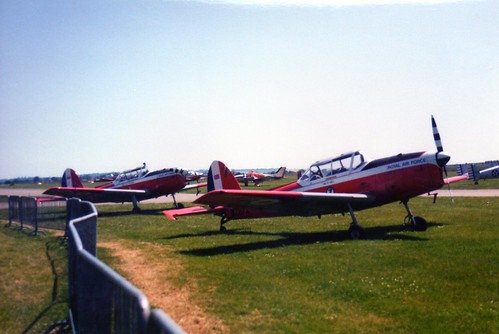
de Havilland Canada DHC-1 Chipmunk by alexdrennan.
The de Havilland Canada DHC-1 Chipmunk is a tandem, two-seat, single-engined primary trainer aircraft which was the standard primary trainer for the Royal Canadian Air Force, Royal Air Force and several other air forces through much of the post-Second World War years. The de Havilland Chipmunk was the first true postwar aviation project of de Havilland Canada.
Today, over 500 DHC-1 Chipmunk (affectionately known as "Chippie") airframes remain airworthy with more being rebuilt every year.
The RAF received 735 Chipmunks, designated Chipmunk T.10, manufactured in the UK. They initially served with Reserve Flying Squadrons (RFS) of the RAF Volunteer Reserve (VR) as well as the University Air Squadrons. A few Chipmunks were pressed into service in Cyprus on internal security flights during the conflict in 1958. From 1956 to 1990 some were used for covert reconnaissance by BRIXMIS operating out of RAF Gatow, Berlin.[citation needed] They were still in service for ATC Air Experience Flights until 1996 (the final AEF to use the Chipmunk was No. 10 Air Experience Flight, RAF Woodvale) when they were replaced by the Bulldog (itself replaced by the Grob Tutor in 1999-2001). Chipmunk T.10s were also used by the Army Air Corps and Fleet Air Arm for primary training. The last Chipmunks in military service are operated by the British historic flights - the RAF Battle of Britain Memorial Flight (including one of the BRIXMIS aircraft), the Royal Navy and Army historic flights, to keep their pilots current on tailwheel aircraft for flying displays in the UK.
Downsview built 217 Chipmunks, the last in 1956.[citation needed] A total of 1,000 were built in Britain initially at Hatfield Aerodrome and then later at Hawarden Aerodrome.[4] A further 66 Chipmunks were licence-manufactured by OGMA (Oficinas Gerais de Material Aeronáutico, at Alverca) from 1955 to 1961 in Portugal for the Portuguese Air Force de Havilland Canada DHC-1 Chipmunk by alexdrennan.
| Country of origin |
| Photos |

Click for large version.
Photo © Glenn Beasley
More photos of De Havilland Canada DHC-1 Chipmunk

Click for large version.
Photo © Allan Jensen
More cockpit photos...
| Powerplants |
Performance
Max speed at sea level 223km/h (120kt), cruising speed 200km/h (108kt). Initial rate of climb 900ft/min. Service ceiling 17,200ft. Max range 450km (243nm). Endurance 2.3 hours.![]()
Weights
Empty 526kg (1158lb), max takeoff 914kg (2014lb).![]()
| Dimensions |
| Capacity |
| Production |
| Type |
History
![]()
Affectionately known as the Chippie, De Havilland Canada's Chipmunk was designed in response to a growing need to replace the Royal Air Force's ageing Tiger Moth two seat basic trainer biplane (described separately).
With a full design workload (courtesy of the revolutionary Comet jet airliner project among others) De Havilland decided to hand design responsibility for the new trainer to its Canadian subsidiary, De Havilland Canada. Design leadership for DHC's first aircraft was the responsibility of W J Jakimiuk who had emigrated to Canada from Poland in 1940 and was previously responsible for the design of the PZL P-24 and PZL P-50 Jastrzab fighters and the DH-95 Flamingo airliner.
His new aircraft was designated the DHC-1 Chipmunk and flew for the first time on May 22 1946. Features of the design included a De Havilland Gipsy Major engine and all metal construction (but with fabric covered control surfaces). First deliveries took place the following year. Main Chipmunk models included the Canadian built DHC-1A-1 and DHC-1B-2 (Mk1 and Mk2 in the RCAF), and many featured clear view blown canopies, while main British production models included the initial T10 for the RAF, the Mk20 for foreign military users and the civilian Mk21. OGMA built 60 Mk20 under licence in Portugal.
Civilianised versions of RAF aircraft became available in large numbers from the late 1950s, and the T10 became the Mk22 in civil service, while the Mk22A was a Mk22 with greater fuel capacity. Farm Aviation Services in the UK heavily modified Chipmunks with a hopper tank in place of the forward cockpit for spraying duties, these aircraft were designated Mk23s. Three similar conversions were performed in Australia by Sasin/Aerostructures as the SA-29 Spraymaster. The Masefield Chipmunk was a conversion available for ex RAF T10s with a blown canopy, wheel pants, luggage space in the wing and increased fuel capacity.
In 1999 a kit version became available for the homebuilt market, developed by Gilles Leger in Montreal, Canada. Leger’s version is called the Super Chipmunk. It has a new more spacious fuselage while using original Chipmunk wings and tail unit, and is powered by a 156kW (210hp) Continental IO-360 engine.
Today the Chipmunk remains a very popular sport and private aircraft, while a small number are still used for pilot training and tailwheel endorsements. Some have also been extensively modified with the installation of Lycoming or Continental engines, e.g. the two Super Chipmunks of famous airshow performer Art Scholl.

No comments:
Post a Comment